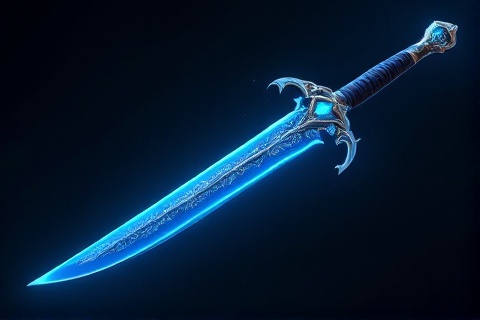
Sting: The Spider-Bane Sword
Bilbo and Frodo's Faithful Elven Blade
Ancient Origins in Gondolin

Sting's origins can be traced back to the legendary First Age city of
Gondolin, where it was forged by skilled
Elven-smiths during the city's golden age. The craftsmanship
displayed in the blade reflects the height of Gondolin's artistry before its
tragic fall to Morgoth's forces.
Though it would later become famous as a hobbit's weapon, Sting
was initially crafted as a knife for the Elven warriors of Gondolin. The blade
served as a secondary weapon for the Noldorin Elves, who
preferred to carry both sword and knife into battle against the forces of
darkness.
Sting belonged to an extraordinary collection of Elvish weapons that included
the mighty swords Glamdring and
Orcrist. These blades were crafted with exceptional skill
and imbued with powerful enchantments that would last through the ages, marking
them as treasures of the Elder Days.
Physical Description and Craftsmanship
While Sting was considered merely a knife by Elvish standards, its size proved
ideal for use as a sword by hobbits. The blade's length and weight perfectly
suited the smaller stature of the Halflings, allowing them to wield it with the
same efficiency as an Elf would a full-sized sword.
The blade of Sting exhibits the characteristic leaf-shaped design favored by
Elvish craftsmen. Its graceful curves and tapered point combine both beauty and
deadly effectiveness, demonstrating the Elves' mastery of both form and function
in their weaponcraft.
The weapon's handle consists of carefully selected hardwood wrapped in
high-quality leather for optimal grip. Ancient Elvish runes decorate the
crossguard and pommel, though their exact meaning has been lost to time.
Despite its ancient origins, Sting's construction showcases the superior
metallurgy of the Elves. The blade's exceptional strength belies its light
weight, while its razor-sharp edge makes it capable of cutting through spider
silk and orc armor with equal ease.
Magical Properties

Among Sting's most remarkable properties is its ability to glow with a cold blue
light when orcs or goblins are nearby. This
enchantment proved invaluable to both Bilbo and
Frodo, warning them of approaching dangers in the dark places of
Middle-earth.
The magical properties of Sting include a resistance to tarnishing and staining
that has preserved its pristine condition through centuries. Even after
encounters with spider ichor, orc blood, and long periods of disuse, the blade
maintains its original luster.
Like other weapons of Gondolin, Sting possesses an enchanted edge that never
dulls. This magical sharpness remains constant without the need for regular
maintenance, making it an ideal weapon for travelers who lack the time or means
to properly care for conventional blades.
Discovery in the Troll's Cave

The remarkable journey of Sting into hobbit hands began in the trollshaws, where
Bilbo Baggins and his dwarf companions discovered it alongside
the legendary swords Glamdring and Orcrist. The three blades lay hidden in the
trolls' cave, waiting to be found by worthy bearers.
The weapons had come into the possession of three trolls who had amassed a
considerable hoard of stolen treasure. These trolls, Tom, Bert, and William, had
likely plundered the blades from other unfortunate travelers, unaware of their
true value and ancient lineage.
Upon discovering the weapons, Gandalf the Grey immediately
recognized their exceptional craftsmanship and ancient origins. His knowledge of
lore allowed him to identify them as weapons from Gondolin, though the full
extent of their history remained unclear even to the wise
wizard.
Earning Its Name
The name 'Sting' was bestowed upon the blade by Bilbo Baggins following his
harrowing adventures in the depths of Mirkwood. The naming
occurred after the weapon proved its worth against the forest's giant spiders,
reflecting Bilbo's growing confidence as an adventurer.
The blade demonstrated remarkable effectiveness against the giant spiders of
Mirkwood, allowing Bilbo to rescue his dwarf companions from certain death. Its
sharp edge easily penetrated the spiders' tough hide, while its length allowed
Bilbo to strike without getting too close to their dangerous fangs.
The name 'Sting' perfectly captured the blade's swift and deadly nature in
combat against arachnids. The spiders themselves came to fear both the blade and
its invisible wielder, crying out in terror at the sting of the unseen attacker.
After naming his trusted weapon, Bilbo had its name inscribed in elegant
Sindarin script along the blade. This personal touch transformed the ancient
Elvish knife into something uniquely his own, marking the beginning of its new
legacy as a weapon of the Shire-folk.
From Bilbo to Frodo

In a touching moment during the Council of Elrond
in Rivendell, Bilbo presented Sting to Frodo along with his mithril coat. The
gifting of these precious items represented Bilbo's trust in his young cousin to
carry forward the legacy of hobbit courage.
The passing of Sting from one hobbit to another symbolized a greater transition
of responsibility between generations. Bilbo recognized that his own adventures
had come to an end, while Frodo's journey was just beginning.
Bilbo's parting with Sting marked an emotional moment of acceptance and growth.
Though the old hobbit had grown deeply attached to the blade during his
adventures, he understood the importance of entrusting it to someone who could
put it to good use in the fight against growing darkness.
Legacy and Cultural Impact

Throughout its history in Middle-earth, Sting came to represent the unexpected
courage found in the smallest and most overlooked beings. The sight of a hobbit
wielding an ancient Elvish blade challenged preconceptions about heroism and
proved that valor comes in all sizes.
Sting's journey from an Elvish knife to a hobbit's sword perfectly exemplifies
how the smallest individuals can impact the course of great events. The blade's
effectiveness in the hands of both Bilbo and Frodo demonstrated that destiny
often chooses unlikely champions.
The legendary status of Sting has influenced countless works of fantasy
literature and media. Its ability to glow in the presence of enemies and its
association with unlikely heroes has inspired many similar magical weapons in
modern storytelling.
Among the famous weapons of Middle-earth, Sting holds a unique position of
honor. While not as renowned as Glamdring the Foe-hammer or Andúril the Flame of
the West, its role in the hands of two hobbit heroes has earned it an enduring
place in the legends of the Third Age.
